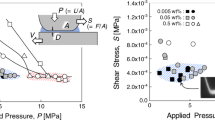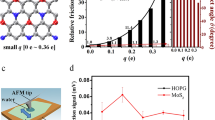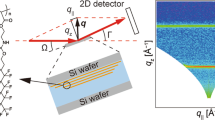Abstract
Recent measurements of the forces acting between two polystyrene layers adsorbed onto mica surfaces, immersed in a poor solvent for the polymer, show strong initial attraction as the surfaces approach, followed by ultimate repulsion1. This has been attributed to attractive osmotic interactions between the adsorbed layers, and possibly to the effect of bridging2,3. We have extended these measurements to the case of polyethylene oxide (PEO) layers adsorbed on mica, immersed in an aqueous 0.1 M KNO3 medium at pH 6 (a good solvent for PEO). Using monodispersed polymer of two molecular weights, we find that an equilibrium force–distance profile is indicated. As the surfaces bearing the adsorbed PEO approach, repulsive forces commence at a surface separation D ≃ 6±1Rs (unperturbed radius of gyration of the respective polymers) and increase monotonically on approach; on subsequent separation the forces decrease monotonically to zero. We find no evidence for attraction or adhesion between the adsorbed layers in this system.
This is a preview of subscription content, access via your institution
Access options
Subscribe to this journal
Receive 51 print issues and online access
$199.00 per year
only $3.90 per issue
Buy this article
- Purchase on Springer Link
- Instant access to full article PDF
Prices may be subject to local taxes which are calculated during checkout
Similar content being viewed by others
References
Klein, J. Nature 288, 248–250 (1980); JCS Faraday I (in the press).
Scheutjens, J. M. H. M. & Fleer, G. J. Adv. Colloid Interface Sci. 16, 361–381 (1982).
Klein, J. & Pincus, P. Macromolecules 15, 1129–1135 (1982).
Israelachvili, J. N. & Adams, G. E. JCS Faraday I 74, 975–1101 (1978).
Grant, W. H., Smith, L. E. & Stromberg, R. R. Disc. Faraday Soc. 59, 209–217 (1976).
Rubio, J. & Kitchener, J. A. J. Colloid Interface Sci. 57, 132–142 (1976).
Stromberg, R. R., Tutas, D. J. & Passaglia, E. J. phys. Chem. 69, 3955–3964 (1965).
Barnett, K. G. et al. Polymer 22, 283–284 (1981).
De Gennes, P. G. Macromolecules 15, 492–500 (1982).
Israelachvili, J. N., Tandon, R. K. & White, L. R. Nature 277, 120–121 (1979); J. Colloid. Interface Sci. 78, 432–446 (1980).
Union Carbide WSR-N80 Product Specification: 1-44K N80-1a, 70320 00, 19-6-1979.
Author information
Authors and Affiliations
Rights and permissions
About this article
Cite this article
Klein, J., Luckham, P. Forces between two adsorbed polyethylene oxide layers immersed in a good aqueous solvent. Nature 300, 429–431 (1982). https://doi.org/10.1038/300429a0
Received:
Accepted:
Issue Date:
DOI: https://doi.org/10.1038/300429a0
This article is cited by
Comments
By submitting a comment you agree to abide by our Terms and Community Guidelines. If you find something abusive or that does not comply with our terms or guidelines please flag it as inappropriate.



